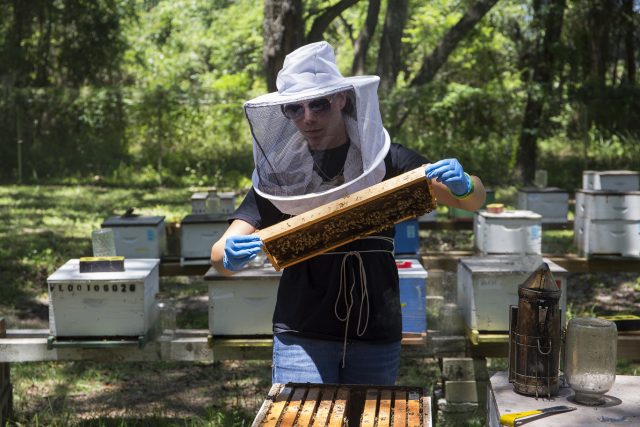
A UF beekeeper inspecting a hive removed from a bee box at the UF Bee Research Unit. Credit: Camila Guillen, UF/IFAS.
With Tupelo season approaching in the next couple of months, February and March is a great time for closer observation and management of honey bee hives. For overall management during late winter – early spring, it’s important to continue feeding colonies, especially if the colony is light or weak. Strong colonies tend to expand during this time, however, so it may soon be time to make nucs/splits and add supers. It’s also a good idea to repair, or paint any equipment needed for the upcoming honey production months.
Nosema
On the disease front, one specific condition to keep an eye on is nosema. This can cause problems for us in North Florida during winter, especially late winter. Worldwide, nosema is the most significant disease to affect bees. The biology of nosema can be described as a single celled fungus. The fungus actually lives in the gut of the bee. Nosema can spread quickly by bee to bee activities such as feeding and cleaning. There are two species of Nosema: apis & ceranae. The species are very difficult to differentiate.
Three symptoms can help diagnose the disease. It’s important to note that this time of year is when the symptoms will be most pronounced. One symptom is when bees are wandering on the ground in front of the hive. But, this is not a true indicator. There are other diseases that cause this behavior. K-wing is also a sign. This is when the forewing and hindwing become detached and form a “K.” Again, not a definitive indicator, as other diseases can also cause this behavior. However, a unique symptom is fecal staining, most notably on bee boxes. This happens when bees are leaving the hive after being confined to the bee box for a long period due to unfavorable weather. The bees simply expel fecal material upon exiting the box.
Controlling nosema is a challenge to say the least. The use of Fumigillin-B is the best course of action. This can be applied to colonies by mixing it with sugar water as feed. However, treating species apis is much easier than treating species ceranae. Colonies may need four gallons of the treatment, if Nosema ceranae is the culprit. Lab results would be needed to conclude which species is present.
Foulbrood
American foulbrood (AFB) and European foulbrood (EFB) are other diseases that can strike a hive. Colonies can be treated with Terramycin or Tylan for AFB prevention or Lincomix or Terramycin for EFB prevention. These products do require a prescription or veterinary feed directive (VFD) from a licensed veterinarian.
Blooming Now
So, what’s blooming now you may ask? For the Panhandle, blueberry, cherry, orange, red maple, plum, Spanish needle, titi, clover, and willow are just some of the potential options for your bees.
The information provided in this article will help you manage your bees through the remainder of the winter season. For more information on beekeeping, please contact your local county extension office.
[important]Don’t forget to sign up for the Panhandle Bee College, Friday & Saturday March 23-24! For Registration, Agenda, and lodging Information, click this Link:
https://www.eventbrite.com/e/panhandle-bee-college-2018-registration-40879931977[/important]
Supporting information for this article can be found at, “February Beekeeping Management Calendar” by Mary Bammer, Extension Coordinator, Honey Bee Research and Extension Lab, and the UF/IFAS Entomology Department’s Nosema Webinar by Dr. James D. Ellis.
- Winter Storm Damage to Your Honeybee Operation? Federal Disaster Assistance Program Could Help - January 12, 2024
- Protect Your Honeybees from Undesirable Plants - June 30, 2023
- Beekeeping in the Panhandle Conference Canceled - April 14, 2023
